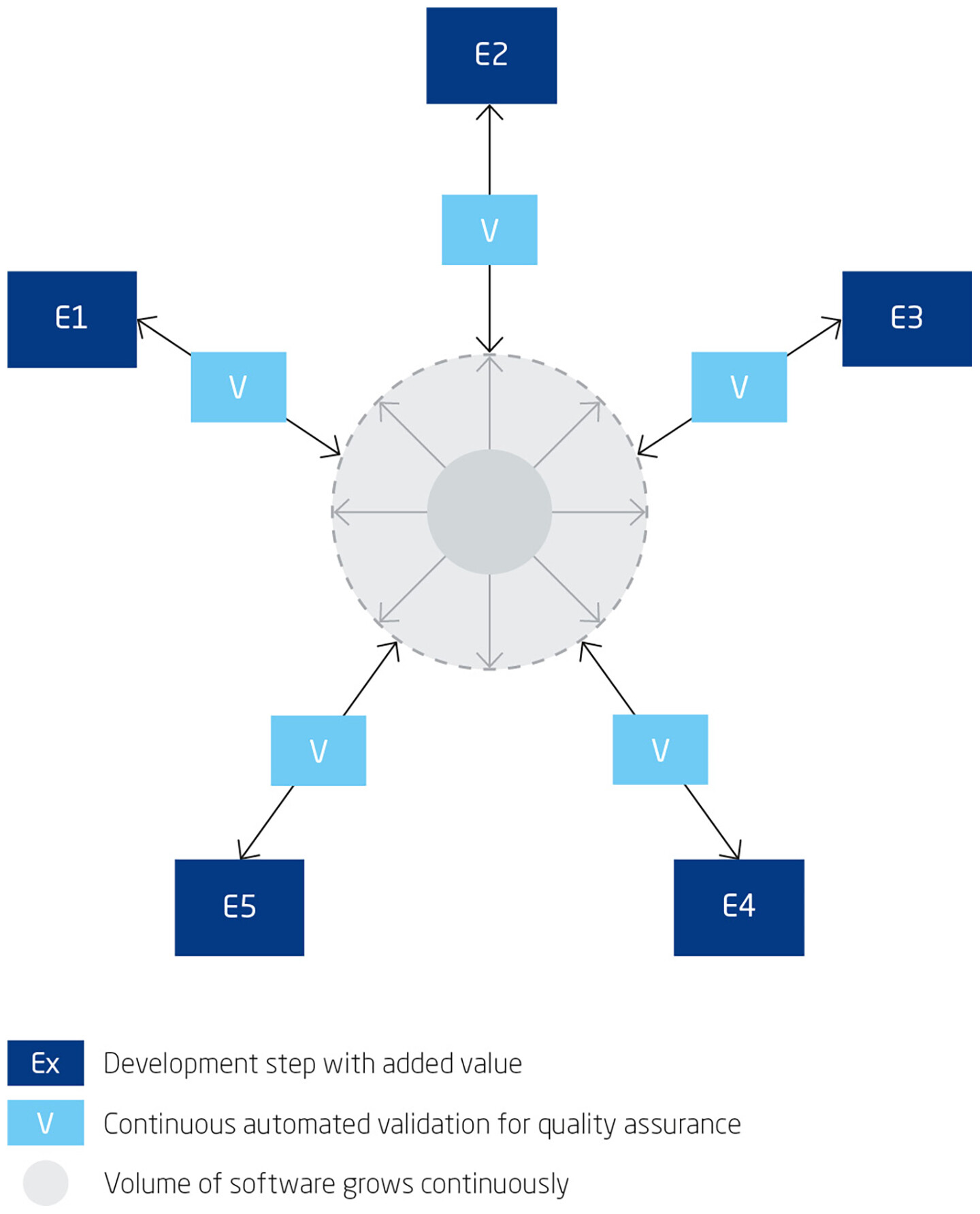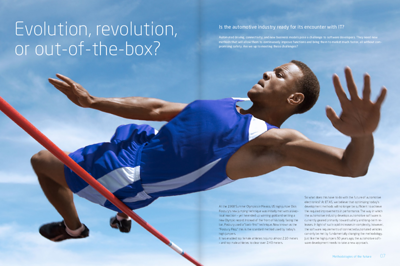Evolution, revolution, or out-of-the-box?
Is the automotive industry ready for its encounter with IT?

Automated driving, connectivity, and new business models pose a challenge to software developers. They need new methods that will allow them to continuously improve functions and bring them to market much faster, all without compromising safety. Are we up to meeting these challenges?
At the 1968 Summer Olympics in Mexico, US high jumper Dick Fosbury’s new jumping technique was initially met with a skeptical reaction – yet he ended up winning gold and setting a new Olympic record. Instead of the front of his body facing the bar, Fosbury used a “back-first” technique. Now known as the “Fosbury Flop,” this is the standard method used by today’s high jumpers. It has enabled top female athletes to jump almost 2.10 meters – and top male athletes to clear over 2.40 meters.
So what does this have to do with the future of automotive electronics? At ETAS, we believe that optimizing today’s development methods will no longer be sufficient to achieve the required improvements in performance. The way in which the automotive industry develops automotive software is currently geared primarily toward safety and long-term releases. In light of such rapid increases in complexity, however, the software requirements of connected automated vehicles can only be met by fundamentally changing the methodology. Just like the high jumpers 50 years ago, the automotive software development needs to take a new approach.
We need to reinvent ourselves
Connected vehicle systems require continuous software development and delivery, both for security and other reasons. This continuous delivery process extends over the vehicle’s entire life cycle, even after the vehicle and its ECUs have rolled off the assembly line. This is especially true in cases where new E/E architectures are taken on board. Developers using powerful, microprocessor-based vehicle computers can place functions anywhere they choose, even when different Automotive Safety Integrity Levels (ASILs) are involved. Increasing inter-action between individual functions causes domains to merge. This means we must also consider functional safety, robustness, and security from an overall system perspective – and that requires a new management and corporate culture.
Virtualization and front-loading are important starting points. But the breakthrough we need cannot be achieved solely by shifting existing process steps into the virtual world. Only by combining this with parallelization, automation, and agile methods can we gain the traction we need to successfully develop automated and connected vehicles.
Forging new paths
In projects that involve cooperation between multiple partners, traditional software development invests significant time and energy in validating previous steps in the development process. In many cases, a new step only begins once the previous step has been completed (Fig. 1). Mistrust in the results delivered by others costs money without adding value for end customers.
Continuous, end-to-end virtualization and integration take a different approach, with all the DevOps partners working with the latest model and software version along the entire value chain. Quickly and easily created Minimum Viable Products (MVPs) enable fast feedback. Customer and development teams recognize errors but also opportunities for improvement at an early stage and can immediately apply the findings to series development.
Validation is carried out in an automated, object-oriented approach (Fig. 2). This ContinuousX parallelization of development and testing makes the process faster – especially when it covers the entire chain from the Tiers to the OEMs and has an impact that extends far beyond the start of series production.

Collaboration should not stop at the company’s boundaries. Instead, all the partners work together on an equal footing and are authorized to integrate and test their current version. Open source plays an important role, too, because speed and interactions are key priorities.
Access to the development platform and many of the development tools is provided through a hosted cloud platform. Teams work on this platform to develop solutions that reflect the selected business model and meet customers’ needs. Consistency between the real and virtual world is essential to ensuring this approach works efficiently. The only questions whether this brave new agile world can withstand a reality in which people entrust their lives to our software.
Our experience
At ETAS, we have spent several years implementing many of the approaches outlined above. We are gradually replacing traditional organizational structures with Scrum teams that use agile methods (see here). Development is shifting to the cloud, where our experts work together with suppliers and enjoy easy access to measurement and development data as well as the latest development tools. Their focus is entirely on the functionality of the software.
Immediate verification on delivery builds trust and reduces costs. Overall, the changes are having a very positive impact. Our customers confirm that we have become better and faster in the relevant areas of our business. They appreciate our ability to offer significantly more cross-functional solutions that provide them with real added value.
We are also gradually aligning our portfolio to the continuous development methodology. Our co-simulation and integration platform COSYM already allows engineers to take a continuous approach to working on MiL, SiL, and HiL platforms – even in the cloud. We are setting new standards for calibrating large volumes of data with the cloud integration of our systems for data logging and the ETAS Analytics Toolbox (EATB). And RTA-VRTE offers an AUTOSAR Adaptive platform software framework for future microprocessor-based vehicle computers that will run software from a wide variety of sources.
Raising the bar
Just like in the world of IT, success depends on continuous monitoring of robust key performance indicators (KPIs). It is important that the indicators measured are uniform and transparent for all those involved. The performance of the overall solution takes priority over that of individual components. This ensures that everyone involved is united in a common effort to prioritize the benefits for the customer. All the key stakeholders must be included for this approach to work.
Vehicles are high-value purchases with a long service life. They will continue to be subject to restrictions in the future with regard to storage, performance, costs, environmental influences, and long operating lives. Security and IP must be guaranteed in the vehicle over long periods of time. For this reason, development approaches from the IT world cannot be transferred 1:1 to meeting our requirements, especially since there is also a need for legal clarification. It will therefore take some time to achieve the goal of continuously connected, virtualized, and agile development processes for automotive software. Yet our positive experiences so far show that we are on the right track.
Summary
There is an urgent need for action. The challenge we all face is how to apply the innovative power and performance of traditional IT methods to the development of vehicle software. New approaches are required that take into account vehicle safety requirements and service life as well as cost pressures in the automotive industry. This course is now being set.
Will this require evolution, revolution, or new out-of-the-box thinking? We believe that all three variants are necessary: evolution of our high safety requirements, a revolution in vehicle architectures, and systematic out-of-the-box thinking about development methodologies for automotive software that will control innovative connected and self-driving cars in the future.
Our portfolio already includes many promising solutions, and further sustainable approaches are in the pipeline. We look forward to achieving new levels of efficiency and performance in collaboration with our customers and partners. Our hope is to create the same kind of enthusiasm among our customers as Dick Fosbury did in 1968 with his new jumping technique.
Authors
Christoph Hartung is President and Chairman of the ETAS Board of Management.
Günter Gromeier is Executive Vice President Sales at ETAS GmbH.
Jürgen Crepin is Senior Marketing and Communications Manager at ETAS GmbH.
-
 Evolution, revolution, or out-of-the-box? Download
Evolution, revolution, or out-of-the-box? Download
